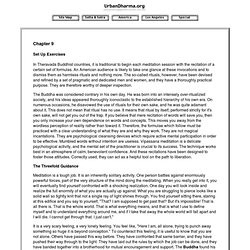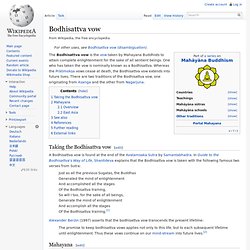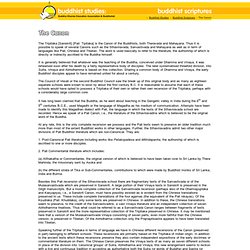

Mindfulness in Plain English - 9. Chapter 9 In Theravada Buddhist countries, it is traditional to begin each meditation session with the recitation of a certain set of formulas.

An American audience is likely to take one glance at these invocations and to dismiss them as harmless rituals and nothing more. The so-called rituals, however, have been devised and refined by a set of pragmatic and dedicated men and women, and they have a thoroughly practical purpose. They are therefore worthy of deeper inspection. The Buddha was considered contrary in his own day.
The Threefold Guidance Meditation is a tough job. It is a very scary feeling, a very lonely feeling. Meditation takes energy. "I am about to tread the very path that has been walked by the Buddha and by his great and holy disciples. Universal Loving-Kindness. Leaf-of-the-bodhi-tree-macro-isolated-on-white-90812954.jpg (450×404)
4010100527_3e09f69f79_z.jpg (640×434) Google Image Result for. Basic Questions on Karma and Rebirth. Singapore, August 10, 1988 Revised excerpt from Berzin, Alexander and Chodron, Thubten.

Glimpse of Reality.Singapore: Amitabha Buddhist Centre, 1999. Question: Is the theory of karma empirical and scientific, or is it accepted on faith? Answer: The idea of karma makes sense in many ways, but there is some misunderstanding about what karma is. Some people think that karma means fate or predestination. In Buddhism, karma refers to impulses. A person may have the impulse to shout at or hurt someone else. Smoking a cigarette is another example. Question: Can someone's receptivity and understanding of Buddhism be predetermined by karma? Answer: There is a great difference between something being predetermined and something being explainable. However, according to Buddhism, things are not predetermined. When an impulse comes in our minds to do an action, we have a choice. Thus, we cannot say that everything – like our understanding or receptivity to the Dharma – is predetermined.
Dhamma - The Dhamma Encyclopedia. From The Dhamma Encyclopedia Dhamma written in ten different scripts.

Mazard's Mechanized Pali Prakrit Alphabetic Table.key. Eightfold-Path2.jpg (1644×2048)
Category:pi:Buddhism. How I Found the Right Teacher of the Dharma. By Ruth Wambui, Guest Contributor Buddhism has become one of the most popular spiritual practices in the world, particularly in the West.

More and more people learning about Buddhism, and adopting one form or another of Buddhist practice. They certainly would have been drawn to the Buddha’s message, the Dharma. They might be drawn by the core message, the focus on personal development, the flexibility of practice, the focus on kindness and generosity. In my experience, you should attempt to find a Buddhist teacher to guide you. His Holiness the Gyalwang Karmapa meets His Holiness the Dalai Lama for the first time upon his arrival in Dharamsala on January 5, 2000. The first step in finding an ideal teacher or guru would be to identify a Buddhist community near you. Buddhist Color Symbolism. 39.2KGoogle +

Monks. Theravada. Bikku bodhi. Saṃsāra. Saṃsāra or Sangsāra (Sanskrit: संसार) (in Tibetan called 'khor ba (pronounced kɔrwɔ [IPA] in many Tibetan dialects), meaning "continuous flow"), is the repeating cycle of birth, life and death (reincarnation) within Hinduism, Buddhism, Bön, Jainism, Taoism,[1] and Yârsân.

In Sikhism this concept is slightly different and looks at one's actions in the present and consequences in the present. Etymology and origin[edit] Saṃsāra means to perpetually wander, to pass through states of existence. Cycle of rebirth[edit] The concept of samsara is closely associated with the belief that the ignorant person continues to be born and reborn in various realms in the form of a human, animal, or other being (depending on karma).[9] Jainism maintains that one who accrues a significant amount of bad karma can also be reborn as a plant or even as a rock,[10] and similar concepts can be found in Purāṇas, in the Bhagavadgītā, in the Manusmṛti[11] and in similar texts.
Samsāra in Hinduism[edit] See also[edit] Bodhisattva vow. The Bodhisattva vow is the vow taken by Mahayana Buddhists to attain complete enlightenment for the sake of all sentient beings.

Buddhist Scriptures: The Canon. The Tripitaka [Sanskrit] [Pali: Tipitaka] is the Canon of the Buddhists, both Theravada and Mahayana.

Thus it is possible to speak of several Canons such as the Sthaviravada, Sarvastivada and Mahayana as well as in term of languages like Pali, Chinese and Tibetan. The word is used basically to refer to the literature, the authorship of which is directly or indirectly ascribed to the Buddha himself. It is generally believed that whatever was the teaching of the Buddha, conceived under Dhamma and Vinaya, it was rehearsed soon after his death by a fairly representative body of disciples. The later systematised threefold division, into Sutta, Vinaya and Abhidhamma is based on this collection. Sharing a common body of Dhamma and Vinaya, the early Buddhist disciples appear to have remained united for about a century. Pali. Buddhist Scriptures: Chart of Pali Canon (Theravada)